Sawyer Squeeze vs. Platypus QuickDraw: A Detailed Comparison
The Platypus QuickDraw is the newest direct competitor to the Sawyer Squeeze – a water filter staple among backpackers and thru-hikers. They have a lot in common and may seem like carbon copies of one another at first glance. However, if you’re someone who has spent as much time around lightweight water filters as I have, there are definitely differences between these two products.
We’re going to get deep into the weeds of both the Squeeze and the QuickDraw here, so prepare to know everything you could ever want to know (and more) about each of them.
Comparison Table
| Sawyer Squeeze | Platypus QuickDraw | |
|---|---|---|
| Claimed Weight | 3 oz / 85 g | 2.2 oz / 62 g |
| Actual Weight | 2.5 oz / 71 g | 2.3 oz / 65 g |
| Removable Cap Weight | 0.2 oz / 6 g | 0.2 oz / 6 g |
| Filter Medium | Hollow-fiber membrane | Hollow-fiber membrane |
| Housing Material | ABS plastic | ABS plastic |
| Dimensions (in) | 5 x 2 | 5 x 1.8 |
| Dimensions (cm) | 12.7 x 5 | 12.7 x 4.6 cm |
| Removes/Destroys | Protozoa and bacteria | Protozoa and bacteria |
| Pore Size | 0.1 microns | 0.2 microns |
| Protozoa Removal | 99.9999% | 99.9% |
| Bacteria Removal | 99.99999% | 99.9999% |
| Integrity Testable | No | Yes |
| Top Cap | Yes | Yes |
| Bottom Cap | No | Yes |
| Inline Compatible | Yes | No |
| Gravity Compatible | Yes | Yes |
| Backflush | Plunger or water bottle sport cap | Shake or any flexible water bottle w/ 28mm opening |
| Compatible Reservoirs | 28mm water bottles, Sawyer bags | 28mm water bottles, Platypus reservoirs |
| MSRP | $36.95 | $29.95 (filter only) / $39.95 (w/ 1L bag) |
Photo Comparison

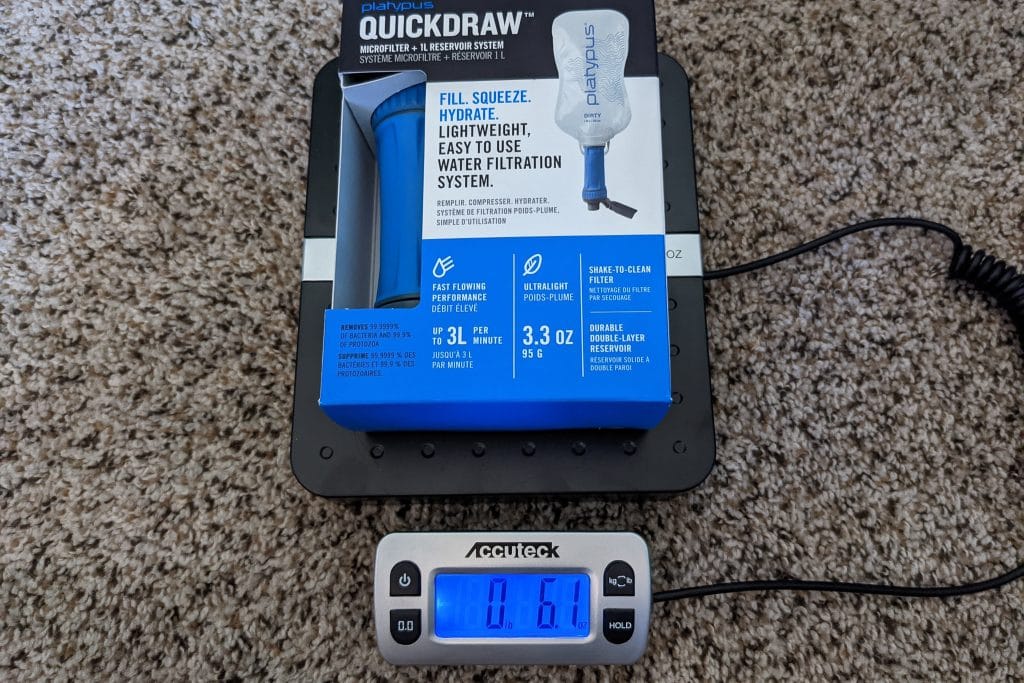







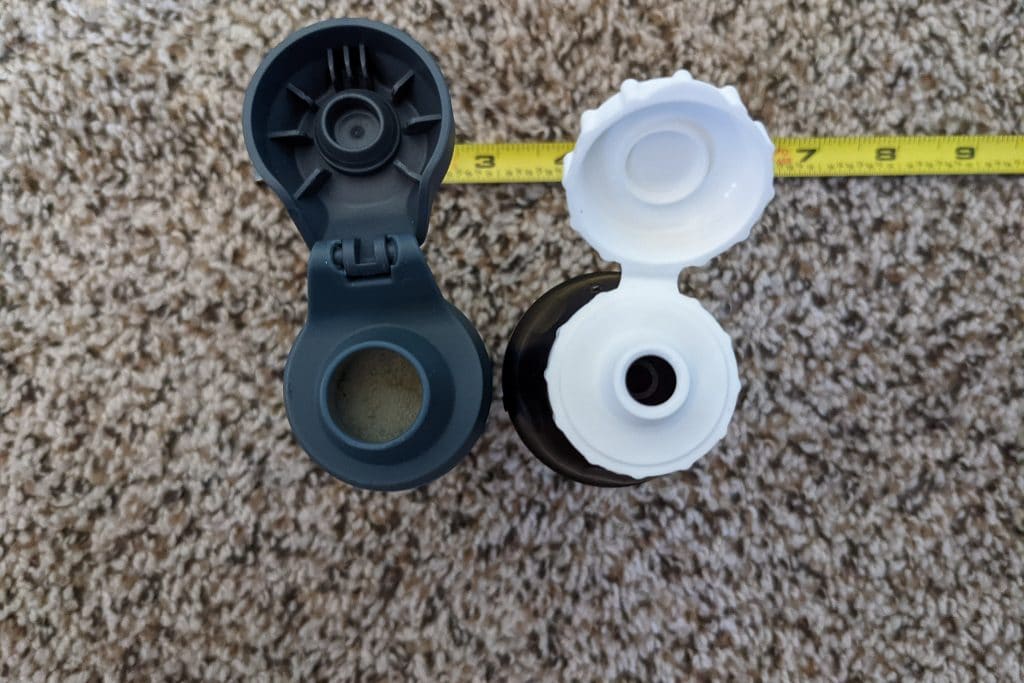





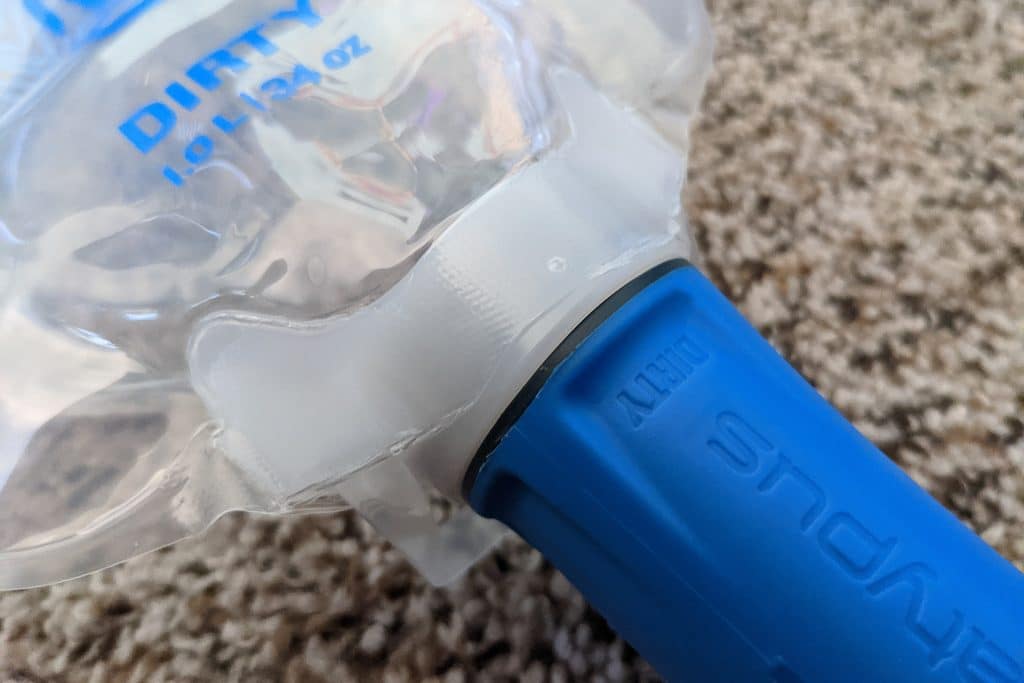


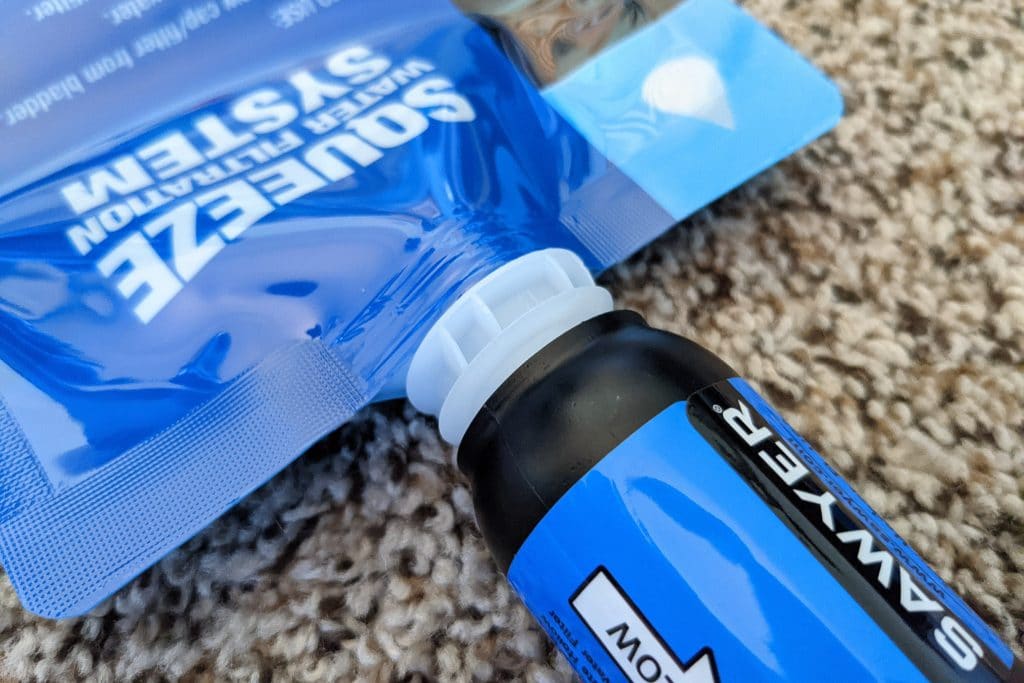





Common Strengths
The Platypus QuickDraw and the Sawyer Squeeze are both exceptionally lightweight hollow-fiber membrane water filters with ABS plastic housings that remove bacteria and protozoa (e.g. giardia) from water sources.
They both can be attached to external reservoirs to filter dirty water and they’re both compatible with most store-bought 28mm PET soda/water bottles (e.g. Smartwater and LIFEWTR bottles). They are nearly identical in size and circumference, but the Sawyer Squeeze is slightly longer and girthier than the Platypus QuickDraw.
Both the Squeeze and the QuickDraw can be backflushed in the field. The Sawyer Squeeze comes with a plunger for backflushing but it can also be attached to a sport cap (the nozzles that some Smartwater, LIFEWTR, and likely other store-bought water bottles come with) and backflushed once you remove the Squeeze’s white cap. The Platypus QuickDraw can either be shaken back and forth (in clean water) or you can press a bottle tight against the top of the QuickDraw and force water through in reverse (similar to using a sport cap with the Squeeze).
They’re both relatively inexpensive, but the QuickDraw (with the filter alone and without the attachable dirty bag) comes in slightly cheaper at $30 vs. $37 for the Sawyer Squeeze.
Common Weaknesses
The biggest complaints about both the Sawyer Squeeze and the Platypus QuickDraw will probably be the diminishment of the filter flow rate over time. How do you prevent this? Backflush your filter with frequency (probably many multiples more than what you’re currently doing). I see a lot of people using these filters in the backcountry. Something I hardly ever see? People backflushing their filters.
A weakness that follows from this is that neither filter is particularly great at filtering for groups. These are best as individual water filters. Even if traveling as a couple, it would be wise for each of you to carry a filter if you expect to be treating large amounts of water.
Another big concern with both filters (and all hollow-fiber membrane filters) is the fact that they can become compromised if allowed to freeze. Residual water inside of the filter can freeze, expand, and damage the membrane which essentially means the filter no longer filters. They’re not great solutions if you’re going to be spending extended periods in below-freezing temperatures (at night, it’s suggested you put your filter in your sleeping bag with you to prevent freezing).
Note: Dropping your filter can also potentially damage the integrity of the hollow fiber membrane.
Lastly, neither filter treats viruses. Viruses aren’t a concern in many parts of the world (this includes much of the United States), but if you’re going to be traveling somewhere you may be exposed to viruses in your water, neither of these filters is for you.
Sawyer Squeeze Strengths
If you were paying close attention to the table above, you may have noted that the Sawyer Squeeze has a filter pore size of 0.1 microns vs the QuickDraw’s 0.2 microns. What’s a micron? It’s a micrometer – yes, the metric system, America. A micrometer is one-millionth of a meter (1×10−6). This can also be expressed as one-thousandth of a millimeter (0.001 mm), or approximately 0.000039 in.
This translates into the Sawyer Squeeze removing 99.9999% of protozoa and 99.99999% of bacteria. The Platypus QuickDraw removes 99.9% of protozoa (that’s three fewer 9s) and 99.9999% of bacteria (one fewer 9). How much difference with the extra 0.0999% of protozoa and 0.00009% of bacteria present in water filtered by the QuickDraw make? I have no idea. But I would assume that this difference wouldn’t make a difference in the overall risk to your health since both products meet the EPA (Environmental Protection Agency) and NSF (National Sanitation Foundation) standards for drinking water.
If you’re interested in learning more about the intricacies of these percentages, MSR has an informative post on the subject.
The Sawyer Squeeze can also be used as an inline water filter. This means that you can connect it to your hydration system/hose and use it to filter dirty water from a reservoir while you drink it through a tube/straw. I’ve never used a Sawyer Squeeze this way, but I have, on occasion, seen people with this setup.
Platypus QuickDraw Strengths
Despite the Platypus QuickDraw and the Sawyer Squeeze being incredibly close when it comes to weight, the QuickDraw is slightly lighter than the Sawyer Squeeze – 2.2 oz / 62 g vs. 3 oz / 85 g. That’s 0.8 oz / 23 g if math isn’t your strong suit. However, on my scale, the Squeeze measured 2.5 oz / 71 g and the QuickDraw measured 2.3 oz / 65 g. Still lighter, but by a smaller margin.
Note: I weighed each of these filters new. This means that there was no residual water in either from previously being used as a filter.
Another advantage to the QuickDraw is the included (removable) bottom cap (which weighs 0.2 oz / 6 g). Typically, I keep my filter attached to a water bottle, but when I need to make sure it doesn’t freeze during the night, I put it in my sleeping bag. With the QuickDraw, the bottom cap means I don’t need to worry about residual water leaking into my bag at night. With the Sawyer, my solution for this is to put the Sawyer into a plastic bag before it goes into my sleeping bag. However, the bottom cap is a much more elegant solution than carrying around a water-soaked bag for nighttime storage.
Something not apparent from the table above – but something I consider to be a strength of the QuickDraw – is that the QuickDraw filter comes with just that, the filter. You can purchase a version that includes a dirty water reservoir, but other than the user guide, that’s everything in the box. The Sawyer Squeeze comes with two Sawyer bags (with caps), a mesh bag, inline filter attachments, an extra o-ring, and a plunger for backflushing. In my personal experience, this all becomes basically trash.
This may be a bit of a hiker misinformation, but I’ve always been under the impression that you should not tighten a Sawyer Squeeze too tightly on water bottles because the water bottle threads are deeper than those on the bags Sawyer provides. Tightening the Squeeze too tightly on a water bottle can damage the O-ring and cause the filter to leak when filtering (or so they say). This is not, however, an issue with the Platypus QuickDraw (as far as I am aware).
Lastly, the Platypus QuickDraw can be tested for integrity. If you fear that the hollow fiber membrane of your filter has been damaged due to freezing temperatures or a drop, you can test your filter to check whether it’s still going to be delivering you clean drinking water. I feel like I need to intentionally break a filter to test this, but according to the instructions provided by Platypus, you can test the filter by following the following steps.
- Fill your reservoir with 1L of water, and attach it to the dirty side of the cartridge.
- Filter approximately half of the water through the cartridge.
- Flip the reservoir upside down so the bottom of the filter (dirty side) is in contact with air inside the empty reservoir.
- Squeeze firmly on the bag for 20 seconds to push air up through the filter.
- During those 20 seconds, look for a steady stream of bubbles in the spout emerging from the hollow fibers on the clean side.
- A steady stream of bubbles indicates the hollow fibers are compromised and the filter is not safe to use.
Lastly, the included reservoir with the QuickDraw is easier to fill up than the bags that come with Sawyer products. The opening is wider and it’s easier to position it below a trickling stream or scoop up water from ponds and lakes.
Conclusion
Both the Platypus QuickDraw and the Sawyer Squeeze are great lightweight water filters for individuals traveling in environments where viruses aren’t a concern and where sustained, daytime, below-freezing temperatures aren’t expected.
Personally, I’ve started defaulting to the QuickDraw, but I haven’t given up on my Squeeze. The Sawyer Squeeze has long been the dominant filter in the long-distance hiking community, and it’s great to see more products making it into the space. Competition breeds innovation, or something like that, right?
If you’re interested in taking a deeper dive on either the QuickDraw or Squeeze, I have detailed reviews of them both – Platypus QuickDraw In-depth Review | Sawyer Squeeze In-depth Review.
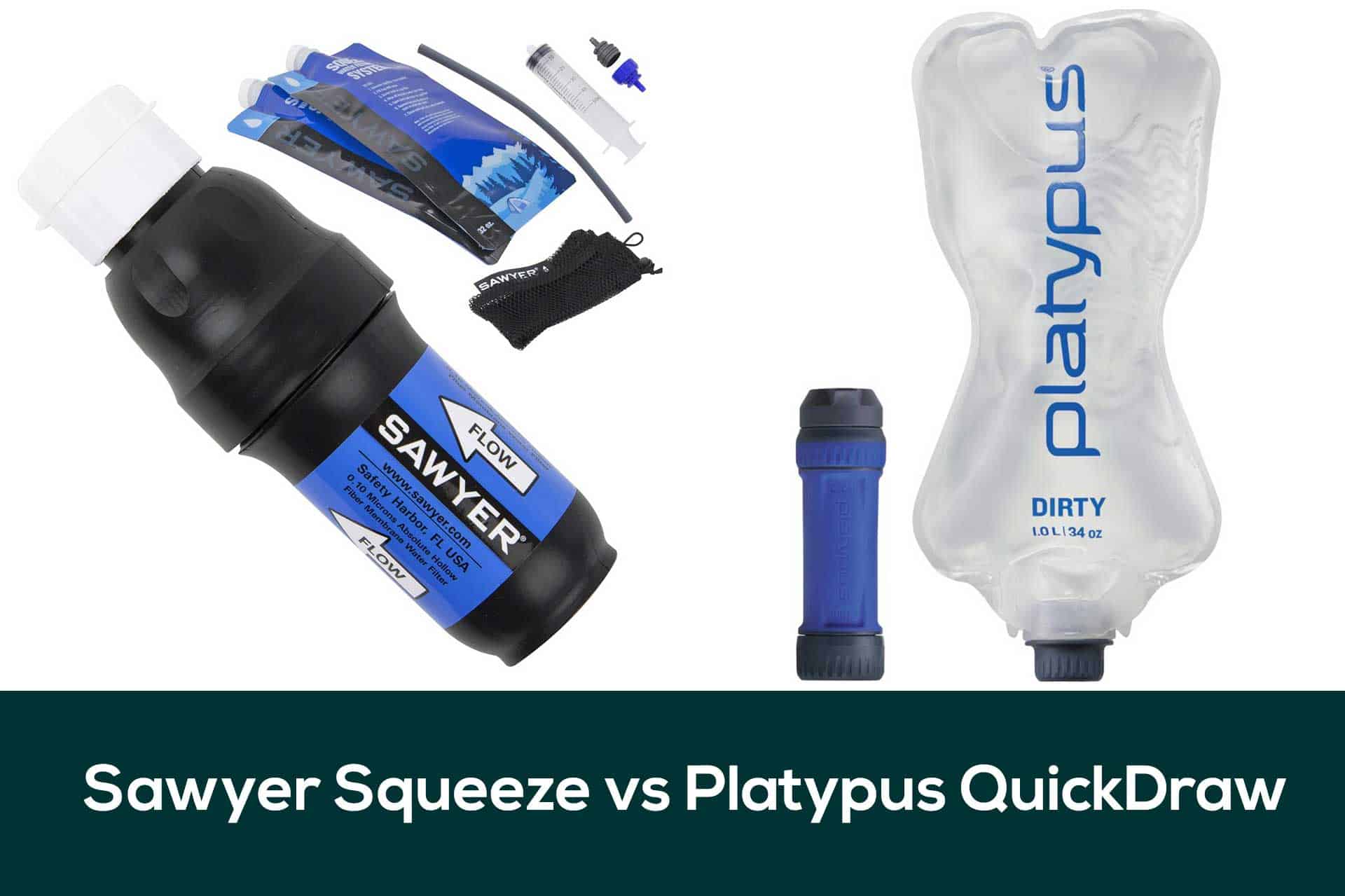

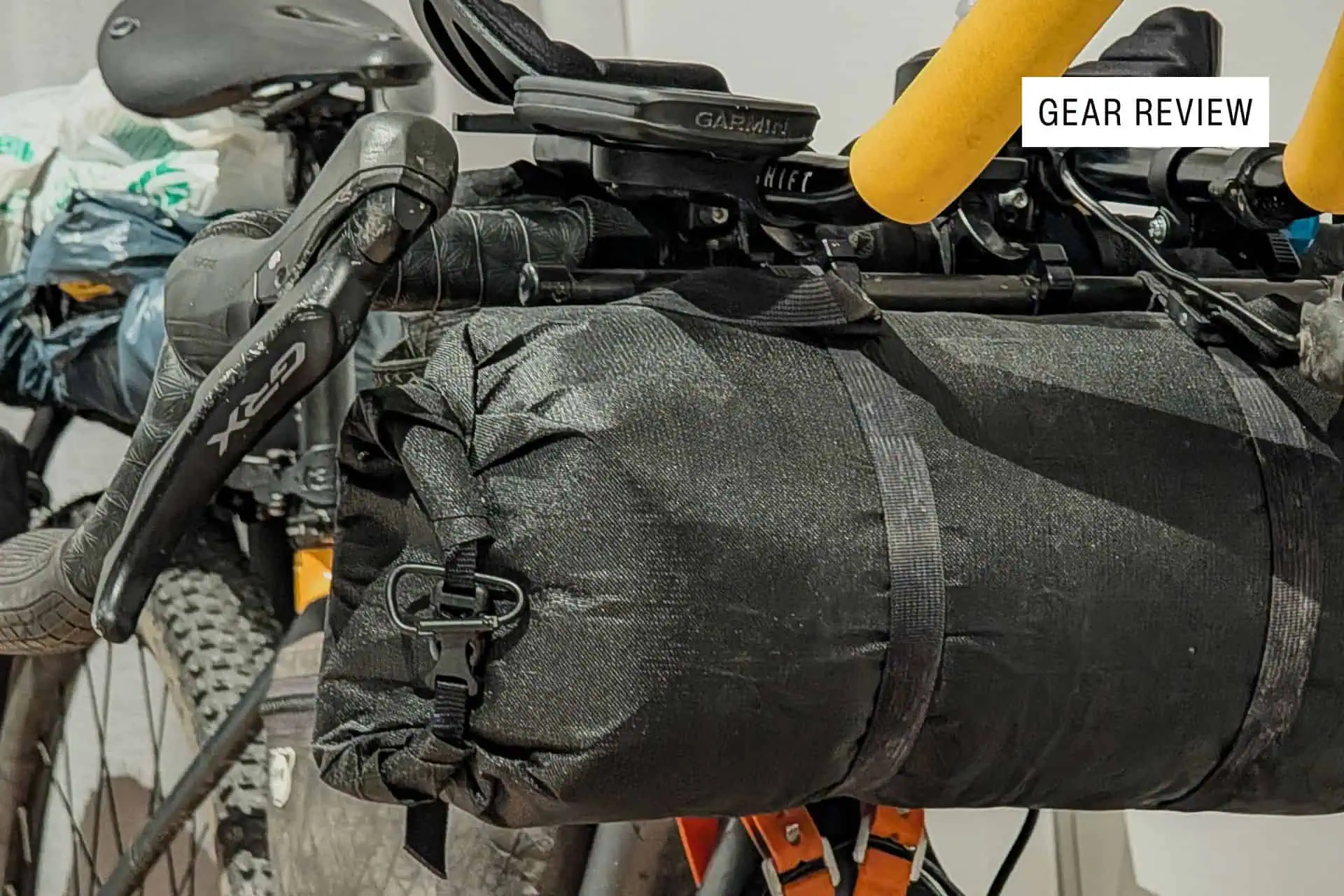

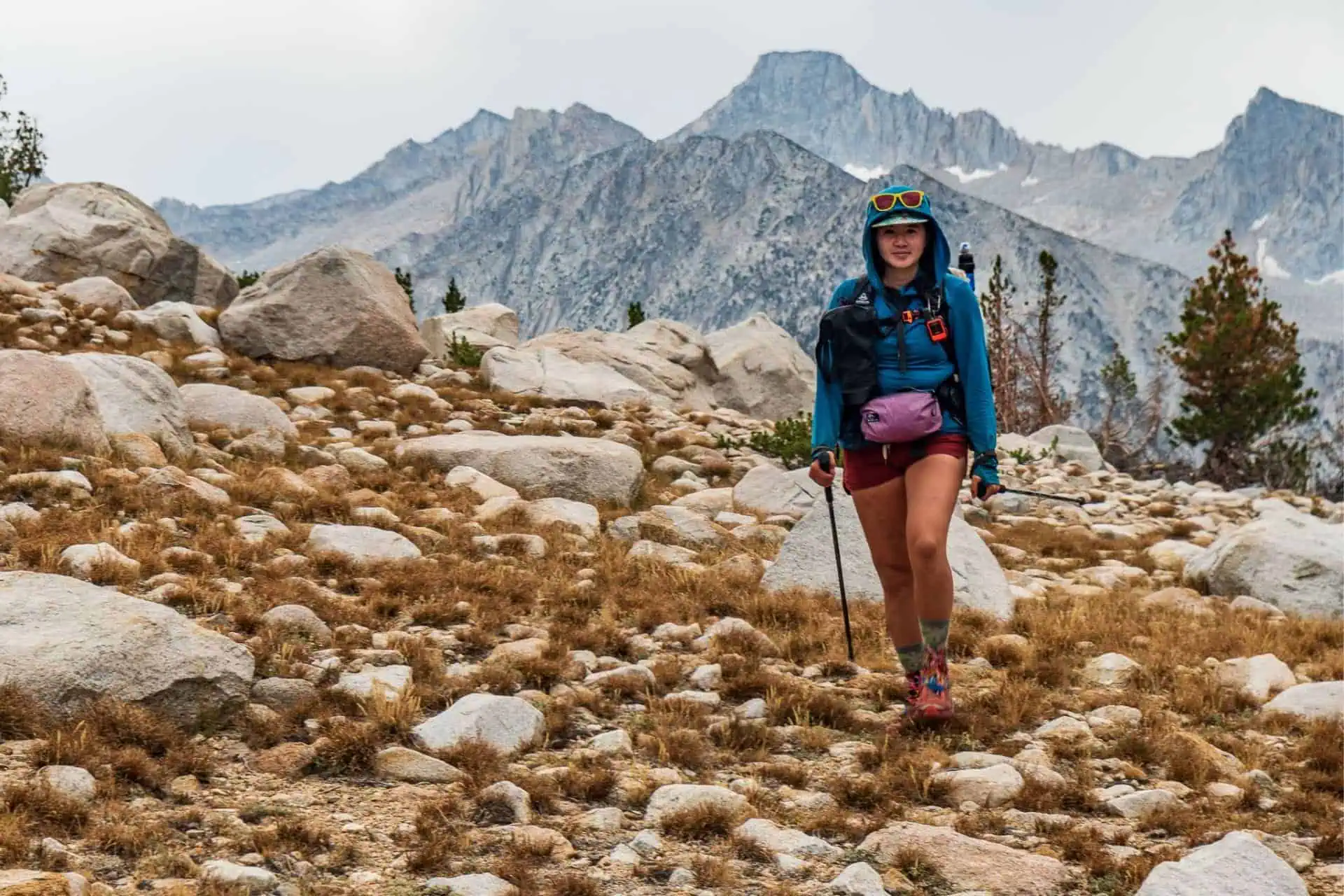
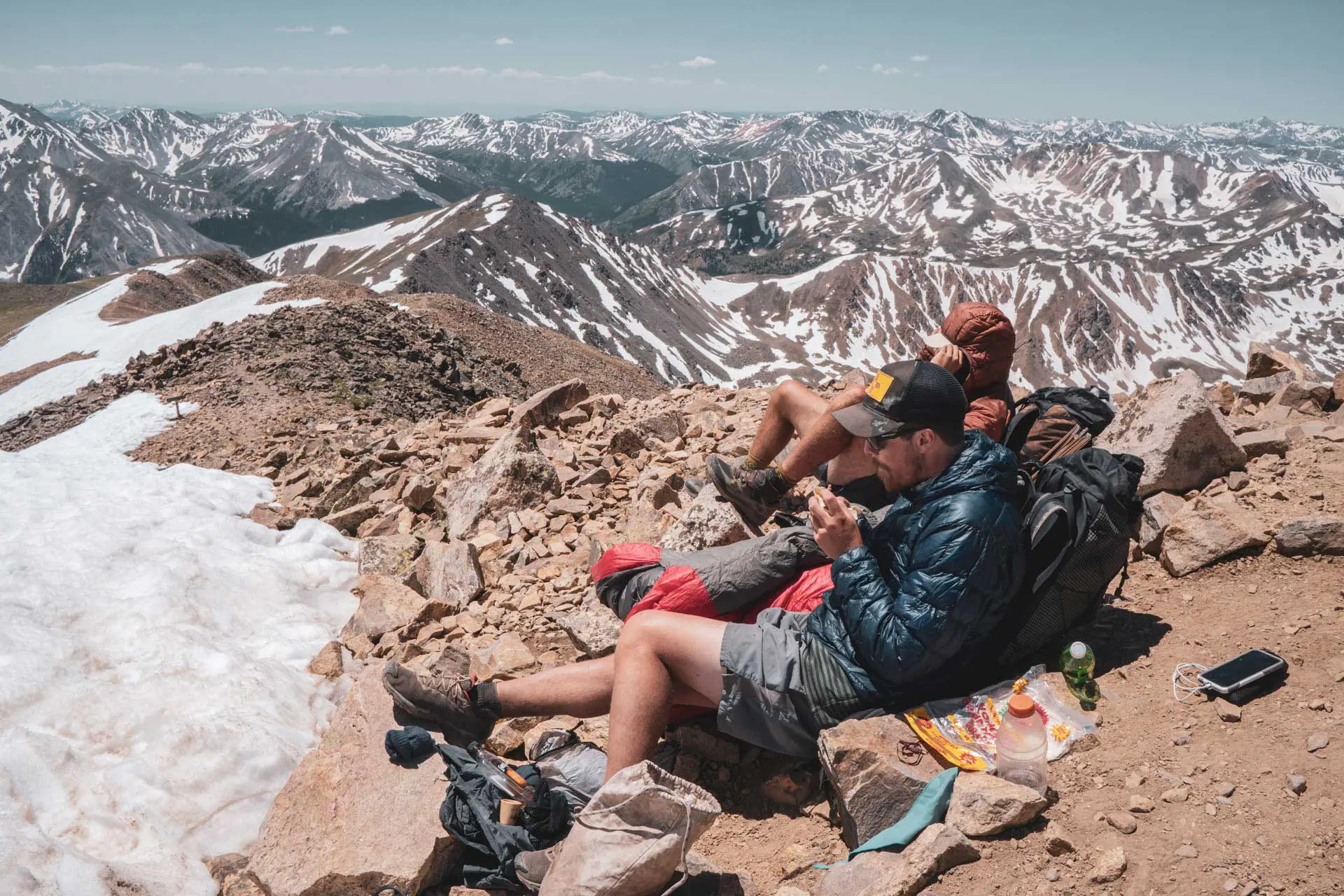
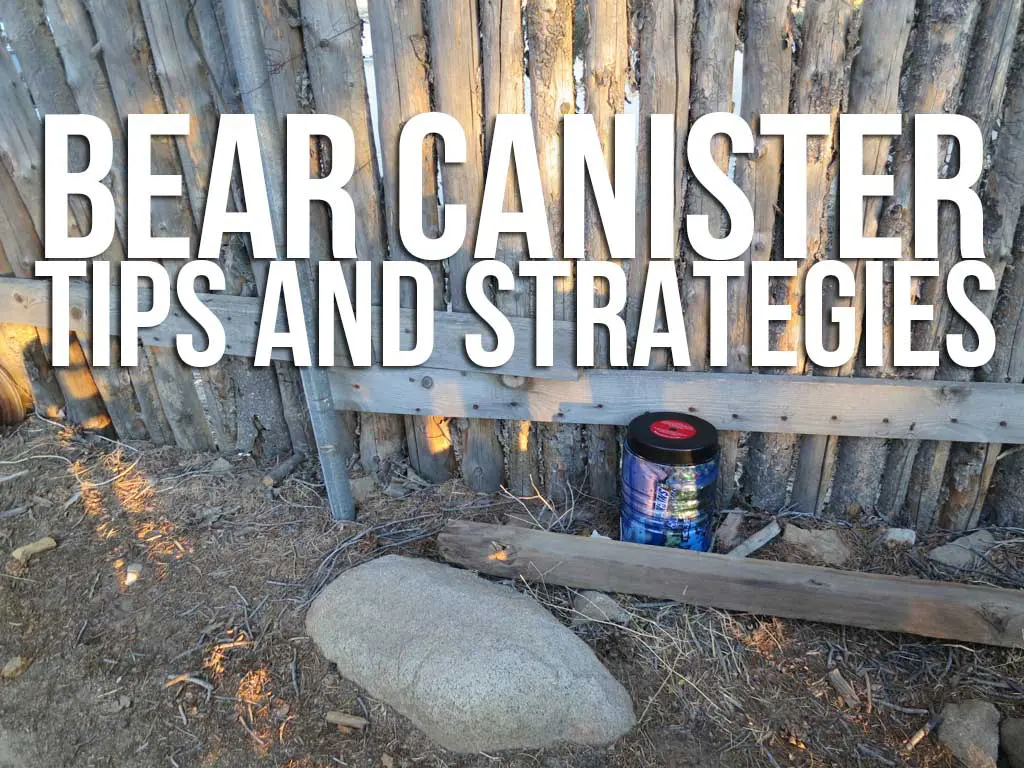
Not mentioned but another I went with the Quickdraw is that filling the included dirty reservoir is much easier than Sawyer bags. There’s a built in handle for dragging it through still water (IE lake) and it provides a better, easier grip in moving water. It’s also much more flexible than the Squeeze’s bags.
This is true! Will give this an add now.